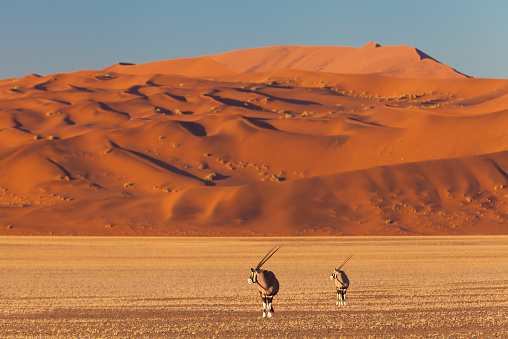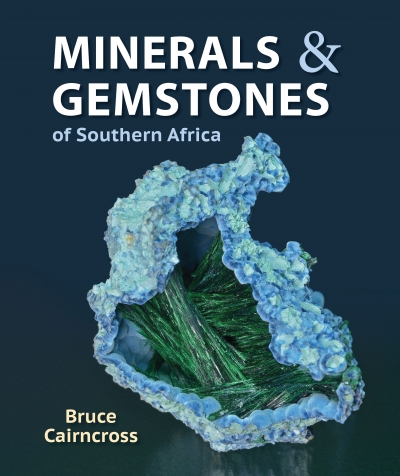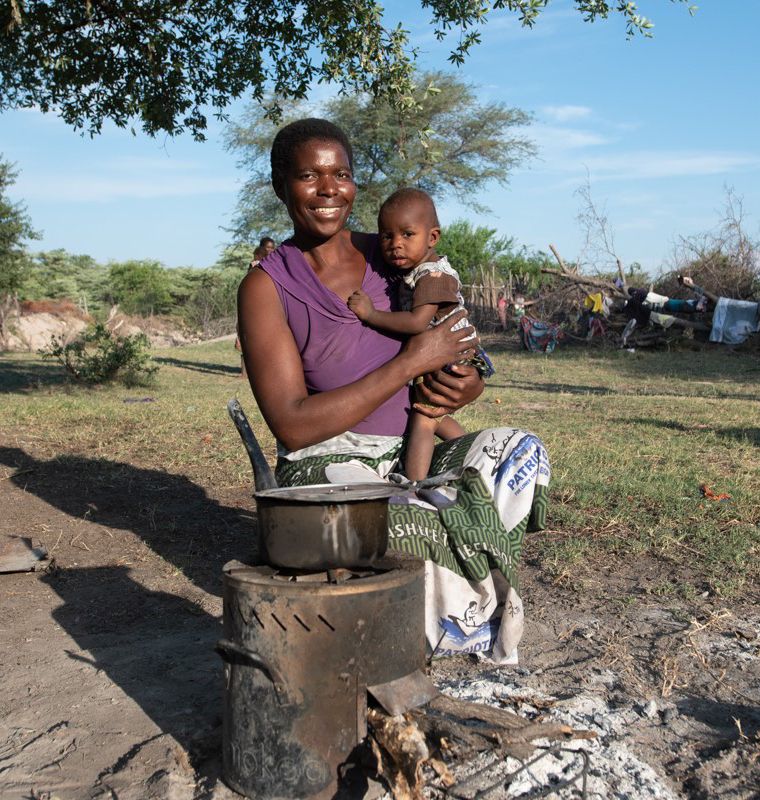DID YOU KNOW The Gambia is the smallest country in mainland Africa? It is mostly a narrow stretch of land that follows the course of the Gambia River, bordered on either side by Senegal. At its widest it is only just over 48 kms making it even smaller than the county of Yorkshire in England.
A birdwatcher’s paradise with 540 species of birds and abundant wildlife in the Kaing National Park and Bao Bolong Wetland Reserve, The Gambia is known for its wonderful beaches on the Atlantic Ocean. Rich in culture and history, it is also home to Jufureh (Juffure) the reputed ancestral village of Kuna Kinte, made famous in Alex Haley’s well-known novel ‘Roots’. (Photo: Abyssinian Roller)
DID YOU KNOW the Selous Game Reserve is the largest Reserve in Africa of 54,600 sq kms?
THAT the largest National Park in Africa is the Namib-Naukluft in western Namibia of nearly 57,799 sq kms?
AND the oldest proclaimed nature reserve is the Hluhluwe-Imfolozi Park (formerly game reserve) of 960 sq kms in Zululand, South Africa?
DID YOUKNOW Africa has 54 countries fully recognized by the United Nations, two independent states with limited or no recognition (Western Sahara and Somaliland), and several territories (mostly islands) controlled by non-African countries?

BREAKING NEWS – Evictions of the Maasai in Tanzania
AFRICA TALKED has been following the demarcation of land and mass evictions of Maasai living legally in registered villages within the Loliondo division of the Ngorongoro district for the last two years.
The situation has worsened with reports of the Tanzania government using violence to forcibly remove the Maasai in order to turn the area into a hunting and tourism venue for the royal family of the UAE.
Recent reports from Tanzania, alongside international condemnation, indicate that on 10 June 2022 at least 3 people had been wounded by live ammunition and teargas. Witnesses have said police fired on protesters, destroyed their property and took their cattle. Ten Maasai leaders were arrested for protesting the eviction and one police officer was reportedly killed.
On 19 June 2022 Joel Ole Nyika wrote:
I am a graduate/ alumni of Pretoria Tech, and was sponsored by world premier hunting organization Safari Club International. I am in communication with SCI leadership and I would like to register their shock and disappointment with what is happening with the indigenous Maasai community in Loliondo/ Ngorongoro Conservation Area. The hunting stakeholders believe that the local communities across Africa are the primary custodians of the wildlife in their land. The hunting fraternity does NOT want to be associated with the forceful eviction of the Maasai people from their ancestral land in Loliondo/ Ngorongoro CA.
ART this month comes from the children of the SANURIRO BATWA COMMUNITY in Uganda, living alongside the gorillas of the Bwindi Impenetrable National Park.
BOOKS
MINERALS & GEMSTONES of SOUTHERN AFRICA by Bruce Cairncross
This beautifully presented book is not only the most up-to-date publication on minerals of Southern Africa, but also the first to feature the region’s gemstones, and is an invaluable guide for collectors, gemologists, and the layman wanting to know more about the environment around them. Covering Botswana, Eswatini, Lesotho, Namibia, South Africa, southern Mozambique and Zimbabwe, this guide gives full mineral species descriptions, with their gemological properties, history, occurrence and uses, all illustrated with striking full colour photographs.
ISBN 978 1 77584 753 3 Published by Struik Nature Penguin Rand House http://www.africatalked.co.za/book-reviews/
MY FIRST AFRICAN ADVENTURE by Riaan Manser with Murray Williams and Chantal Tarling, Illustrated by Martinus van Tee.
In September 2003, Riann Manser rode out of Cape Town to circumnavigate Africa by bicycle. It took two years, after which he wrote his best-selling book ‘Around Africa on My Bicycle.’
MY FIRST AFRIC AN ADVENTURE is that expedition written for children and young adults. With highly amusing coloured illustrations, some personal notes on what Riaan experienced, the reader can visit all 34 countries that he cycled through. Lots of fun, some scary times, interesting things he saw and did, and some very strange people along the way, all added to the adventure of discovery that is shared by Riaan in this entertaining and amusing book. Great fun and a wonderful way to learn more about Africa!
ISBN 978 1 7763 5372 9 Published by Struik Children/Penguin Random House
THE WORLD OF AFRICAN WILDLIFE: A Safari Guide for Young Explorers by Owen Hendry
SUPERB! This is an excellent and entertaining guide. Young explorers are shown what to look for, how to track, the whys-and-wherefores of survival in the wilds for animals, birds and reptiles. There are hundreds of colour photographs, simple questions (with answers) interesting facts and figures, how to track, what to watch out for – it is all in this beautifully presented glossy,64 page, A4 size book. A source of information, some well-known, some little known, will intrigue adults as well as young wildlife enthusiasts.
ISBN 978 1 77584 805 Published by Struik Nature/Penguin Random House
KAVANGO ZAMBEZI: Peace Parks Foundation, in partnership with COmON Foundation and Commonland Foundation (Netherlands), together with the African Stove Company (TASC, Jersey UK), have distributed 10 000 cook-stoves to low-income households in Simalaha, Kavango Zambezi Transfrontier Conservation Area. These especially designed stoves are 60% more efficient than open fires, use less wood and smoke. Thanks to Gold Standard accreditation, Simalaha can trade carbon credits thus developing revenue for the area. (Source: Peace parks Foundation)
“Zidele Amathambo” Give yourself up, Bones as well (Meaning – take a chance) A South African Ndebele saying.
ZAMBIA: Community Markets for Conservation (COMACO), together with the Department of National Parks and Wildlife, have established the Association of Transformed Hunters (originally referred to as transformed poachers). An offspring of this association is a growing “troop” of volunteer “chilli blasters” who watch over crops with guns that fire chilli and not bullets to scare off crop raiding elephants and hippos. Working across 12 chiefdoms in the Luangwa Valley the volunteers use muzzle-loading guns to shoot small paper packages of finely ground chilli pepper that explode into vapour, causing a painful sensation when breathing, elephants quickly turn away and flee, staying clear of farmers’ crops for several weeks.
News from an Africa Talked’s Selected Destinations
OBSERVE WILDLIFE sent this photo taken by guests from Houston, Texas, whilst with
Kaz Dube at Kennedy Camp, Hwange National Park.
“This male lion was photographed about 700 meters from our KENNEDY SAFARI CAMP. The abundance and diversity of wildlife that we have seen in the past week cannot be fully showcased in detail on email.” www.africatalked.co.za/where-to-go-in-africa
Mozambique: Many breeding nests of the Taita falcon have been discovered on the inselbergs of Mozambique’s Niassa Special Reserve. No more than 1,000 Taita falcons remain in Africa.
SHEA TREE
Vitellaria paradoxa (formerly Butyrospermum parkii), commonly known at the Shea tree, Shi tree or Karité, a tree of the family Sapotacea, is the only species in the genus Vitellaria and is indigenous to Africa.
Shea trees grow in 19 countries across a narrow belt of fertile, well-drained soils in the savannah stretching from West Africa to East Africa. It is a deciduous tree, growing 7 – 15 m tall but has been known to grow up to 25 m. The tree starts bearing fruit when it is 10 – 15 years old, full production at about 20 – 30 years old. It can bear fruit (nuts) for up to 200 years.
The Shea tree is a traditional African food plant from which shea butter is produced. In traditional medicine it is used in the treatment of several ailments andsupports wound healing and decreases skin irritation. Shea butter is also used as an anti-inflammatory agent, treats rashes in children, dermatitis, chapping, and ulcers. The fruit resembles large plums which take 4 – 6 months to ripen, is a thin tart nutritious pulp that surrounds a relatively large oil-rich seed/nut. Classified as ‘vulnerable’, due to its cultural heritage, role in local cuisines, women’s income, agro-ecology, and growing global trade value, the loss of Shea trees is alarming. Although cultural taboos and laws forbid destroying them, the cutting down of Shea trees has grown and has become a regional environmental concern. With the wealth of shea butter products on beauty aisles globally, the growing threat to shea trees remains distressing.
Lesley & Ian Thomson
AFRICA TALKED
E:africatalks@africatalked.c.za W: www.africatalked.co.za
FB: Africa Talked all about Africa
Linkedin: Lesley Cripps Thomson
- Are you raising funds for conservation,
a charity or your favourite NGO?
Want to sponsor an artist or new author?
WE CAN HELP.
Contact: africatalks@africatalked.co.za
This is a free not for profit newsletter to help create awareness of Africa and encourage people to visit.
Please pass it on to friends and colleagues.
Should you wish to make a donation towards the production of this newsletter that goes world-wide, it would be very gratefully accepted and acknowledged.













